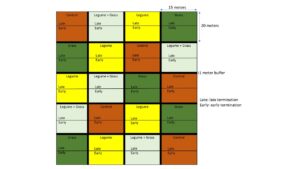Project Overview
Commodities
Practices
Proposal abstract:
As cover crops gain popularity in the Lower Rio Grande Valley (LRGV), farmers in both irrigated and dryland systems encounter additional challenges alongside existing issues soil as soil moisture loss and lack of technology for proper cover crop termination. Due to lesser water use and the potential to improve soil nitrogen status, the two major limiting factors for growers in LRGV, growers prefer legumes over non-legume species. Despite the benefits of reduced weed pressure and soil erosion through cover cropping, growers now grapple with a new issue, higher nitrogen loss in legume cover cropped fields compared to fallow fields. The unique climatic circumstances in the regions posed by sub-tropical semi-arid conditions, distinct from other parts of the country, necessitates a stie-specific information to effectively implement cover cropping.
The release rate of nitrogen from various cover crops is influenced by their functional types, such as C3 vs C4 grasses and legumes, as well as factors like soil microbial community and background soil properties. To address this issue, we propose incorporating grasses into the cover crop mix and closely monitoring water usage, total nitrogen reserves in the soil, soil microbial community dynamics, and background soil properties. Building on previous research findings, we anticipate that the inclusion of grasses—with their higher lignin content and C:N ratios—has the potential to mitigate nitrous oxide (N2O) emissions and augment soil nitrogen reserves for subsequent commodity crops (Singh et al., 2020).
By consistently monitoring soil moisture levels, leaf nitrogen content and plant stomatal conductance, we aim to estimate plant water usage and identify optimal timings for cover crop termination. The addition of grasses to legume cover crops is expected to balance the C:N ratio in the soil, slowing the decomposition process and reducing nitrogen release, making it more available for subsequent crops while mitigating the release of a potent greenhouse gas. Moreover, grasses serve as effective nutrient scavengers, preventing the loss of residual nitrogen from previous commodity crops. We believe that with the evaluation of plant traits related to their growth, development, and physiology we can develop a comprehensive cover crop management plan tailored to the specific challenges faced by growers in the LRGV.
Project objectives from proposal:
This study will be conducted in an organic vegetable farm in Edinburg Texas for two-year 2024 and 2025. In both years, at the end of May (end of vegetable growing season), the 2-acre field will be plowed and divided into 20 equal plots (each plot approximately 20m x 15m in size) with a 1m buffer in between each plot as shown in Figure 1. This experiment will have 4 cover crop treatments: legume only, grass only, grass-legume mix (50:50), and a fallow control each replicated 5 times. The cover crops included in this study include grass: sudangrass (Sorghum × drummondii) and legume: sunn hemp (Crotalaria juncea). The seeds will be planted at the recommended rate, the legumes will be treated with the recommended rhizobia inoculum before planting. The edges will be cultivated to manage weeds. The control plots will receive no treatment allowing weeds to grow. Cover crops in half of each treatment plot will be terminated mid-July before the sunn hemp start flowering and the remaining half will be terminated after sunn hemp produce flowers, during the third week of July (approximate timeline) Cover crops will be terminated using a flail mower and will be incorporated into the soil (as preferred by the participating farm).
Field data collection and analysis:
Soil samples will be collected from each treatment plot and soil physical, chemical, and biological analysis will be performed during the 2-year study period. From each treatment subplot, 5 random soil samples will be collected at 0-20cm depth using a 2.5 cm diameter soil probe pre and post-cover crops and after cash crop establishment in the field. The soil samples will be thoroughly mixed and separated into two portions. One portion will be placed in air-tight containers and shipped to the Ward Laboratories (https://www.wardlab.com/services/soil-health-analysis/) for microbial community (PLFA) and soil health assessment. The PLFA analysis will include the estimation of the living biomass of different soil functional groups including total bacteria (Gram + and Gram -), Total Fungi (AMF and saprophytes), Protozoa, and undifferentiated biomass. Soil health assessment will include soil micro- and macronutrients, water stable aggregates, microbially active carbon, nitrogen release, nitrogen reserve. The second portion of soil samples will be air-dried and analyzed for soil moisture, soil organic matter, total carbon and nitrogen in PI’s laboratory at UTRGV. Soil moisture in each of the treatment plots will be recorded every week using a Soil Moisture Meter.
Stomatal conductance and chlorophyll fluorescence will be measured weekly to document the ecophysiology of the two cover crop types. Stomatal conductance and chlorophyll content will be measured in the field using a LICOR Porometer/Fluorometer, LI-600N. Cover crop leaf tissues will be collected every week until termination, dried to constant weight, finely ground, and analyzed for C: N ratio using a LECO 928 Series Macro Determinator in PI’s laboratory. Cover crop biomass at the time of termination from each treatment plot will be collected from each treatment plot from randomly selected 1m x 1 m sub-plot. The above-ground plant parts will be dried in an oven to constant weight and weighed to estimate the total above-ground cover crop biomass.
Data Analysis
All data will be tested for normality and normalized if necessary. The selected soil parameters will be compared among the different treatments done using a T-test. Analysis of variance will be done to compare the differences in properties between different different treatments. Multivariate analysis will be done to evaluate the association among different soil and cover crop biomass variables. Repeated measures ANOVA will be done to compare the C:N ratios in leaf tissue of the two cover species collected every two weeks. All data will be analyzed using R statistical software.
